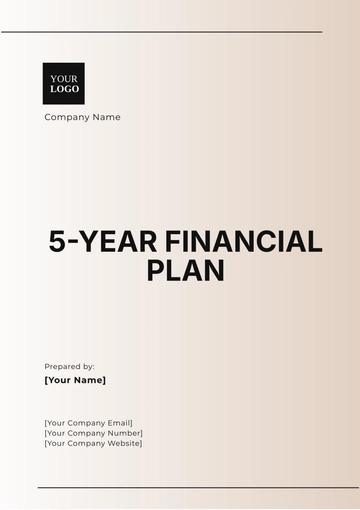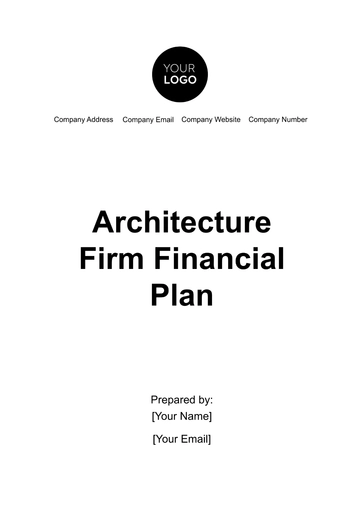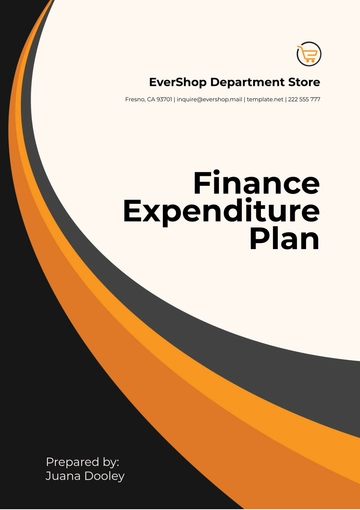Free Long-Term Financial Procedures Plan

Executive Summary
[Your Company Name], a leading technology solutions provider based in [Detroit, Michigan], is dedicated to establishing resilient financial procedures aimed at ensuring sustained growth and stability. This plan encapsulates a strategic roadmap that spans multiple years, outlining key initiatives and methodologies to fortify financial foundations.
Introduction
A. Background
Founded in [2050], [Your Company Name] has rapidly evolved into a prominent player in the technology sector. With a robust portfolio of innovative products and services, the company has witnessed consistent growth over the past decade. As we embark on this Long-Term Financial Procedures Plan, it is crucial to recognize the dynamic nature of our industry and the need for adaptive financial strategies.
B. Objectives
Our primary objectives in formulating this plan are to:
Secure and enhance financial stability.
Facilitate informed decision-making through transparent financial reporting.
Implement proactive risk management measures.
Optimize resource allocation for sustainable growth.
Governance and Oversight
A. Finance Committee
To ensure effective governance, [Your Company Name] establishes a Finance Committee comprising:
Chairperson: [John Dale]
Members: [Jane Smith] (Chief Executive Officer), [Robert Johnson] (Chief Operating Officer), [Emily Brown] (Finance Manager)
The committee will convene quarterly, commencing on the first Friday of Q1, to review financial performance, discuss strategic financial decisions, and ensure compliance with established procedures.
B. Key Roles and Responsibilities
Chief Financial Officer (CFO): [John Dale] will spearhead the overall financial strategy, ensuring alignment with organizational goals and regulatory compliance.
Finance Manager: [Emily Brown] will oversee day-to-day financial operations, including budgeting, financial reporting, and ensuring the accuracy of financial data.
Audit Manager: [Robert Johnson] will coordinate both internal and external audits, ensuring that financial practices adhere to regulatory standards and internal policies.
Budgeting
A. Annual Budget
For the fiscal year 2055-2056, [Your Company Name] anticipates the following financial projections:
Total Revenue: | [$50 million] |
Operating Expenses: | [$35 million] |
Net Profit Target: | [$15 million] |
Budget allocations will prioritize:
Research and Development: | [$12 million] |
Marketing: | [$8 million] |
Technology Infrastructure Enhancements: | [$5 million] |
B. Budget Approval Process
The budget approval process involves a systematic approach to ensure accuracy and alignment with strategic goals:
Submission of Proposals: Department Heads will submit detailed budget proposals by [January 15, 2055].
Committee Review: The Finance Committee, led by [John Dale], will review proposals, suggesting adjustments to align with overall company objectives.
Final Approval: The finalized budget will be presented for approval by the Board of Directors/Executive Team on [February 1, 2055].
Upon approval, the budget becomes effective on the first day of the fiscal year, starting [March 1, 2055].
Financial Reporting
A. Frequency and Types of Reports
Financial reports at [Your Company Name] will be generated on a monthly and quarterly basis, offering comprehensive insights into the company's financial health.
Report Type | Frequency | Distribution |
|---|---|---|
Income Statements | Monthly | Executives, Department Heads |
B. Key Performance Indicators (KPIs)
To gauge financial performance, [Your Company Name] will track the following KPIs:
Revenue Growth Rate: Targeting a [10%] annual increase.
Operating Profit Margin: Maintaining a minimum of [15%].
Debt-to-Equity Ratio: Maintaining a ratio below [0.5].
Cash Flow Management
A. Cash Flow Forecasting
Cash flow forecasting will be conducted monthly, projecting income and expenditures for the upcoming 12 months.
Month Projected | Income | Projected Expenditure | Net Cash Flow |
|---|---|---|---|
[Jan 2055] | [$20 million] | [$15 million] | [$5 million] |
B. Working Capital Management
Efficient working capital management strategies will be employed to maintain a healthy balance between current assets and liabilities.
Component | Target Value |
|---|---|
Current Ratio | [2:1] |
Risk Management
A. Identification of Financial Risks
[Your Company Name] recognizes the importance of identifying potential financial risks to proactively address and mitigate them. Key financial risks include:
Risk Category | Specific Risks |
|---|---|
Market Risks | Fluctuations in currency exchange rates |
Changes in interest rates | |
B. Mitigation Strategies
Mitigation strategies for identified risks include:
Risk Category | Mitigation Strategies |
|---|---|
Market Risks | Hedge against currency fluctuations |
Diversify investments to reduce dependence on one market | |
Investments
A. Investment Policy
[Your Company Name] outlines a prudent investment policy to guide investment decisions. The policy includes:
Investment Objectives: Achieve a balanced portfolio that combines stability and growth.
Risk Tolerance: Maintain a moderate risk tolerance, with a focus on long-term returns.
Asset Allocation: Diversify investments across equities, fixed income, and alternative investments.
B. Portfolio Diversification
Diversification strategies for the investment portfolio include:
Debt Management
A. Debt Structure
[Your Company Name] maintains a strategic approach to debt management to optimize capital structure. The current debt structure includes:
Debt Instrument | Amount | Interest Rate | Maturity Date |
|---|---|---|---|
Long-Term Loans | [$20 million] | [4.5%] | [Dec 31, 2055] |
The long-term loans provide stability with a fixed interest rate, while the revolving credit line offers flexibility to manage short-term liquidity needs. The variable interest rate on the credit line ensures alignment with market conditions.
B. Debt-to-Equity Ratio
The company aims to maintain a prudent debt-to-equity ratio below [0.3] to ensure financial stability and minimize financial risk. As of the latest financial statement, the current debt-to-equity ratio stands at [0.25], reflecting a healthy balance between debt and equity financing.
Auditing and Compliance
A. Internal Audits
Internal audits at [Your Company Name] are conducted semi-annually by an internal audit team led by [Internal Audit Manager]. The scope of internal audits covers:
Financial processes and controls: Ensuring accuracy and reliability in financial reporting.
Compliance with company policies: Verifying adherence to established internal policies and procedures.
Operational efficiency assessments: Identifying areas for process improvement and cost-effectiveness.
The findings from internal audits are presented to the Finance Committee for review and action.
B. External Audits
External audits are conducted annually by [External Audit Firm], an independent auditing firm. The audit covers:
Financial statements: Verifying the accuracy and completeness of financial statements.
Compliance with regulatory standards: Ensuring adherence to industry regulations and reporting requirements.
Overall financial practices: Assessing the effectiveness of financial controls and risk management.
Review and Evaluation
A. Periodic Review
[Your Company Name] acknowledges the importance of periodic reviews to ensure the effectiveness of the Long-Term Financial Procedures Plan. The Finance Committee will conduct a comprehensive review:
Quarterly: Assess the performance of financial strategies, evaluate key performance indicators, and address any emerging financial challenges.
Annually: Conduct a thorough annual review to analyze the alignment of financial procedures with organizational goals. Adjustments to the plan will be made based on market trends, regulatory changes, and internal assessments.
B. Continuous Improvement
Continuous improvement is integral to [Your Company Name]'s financial management approach. To foster ongoing enhancement:
Feedback Mechanism: Establish a feedback mechanism for employees to provide insights and suggestions related to financial procedures.
Benchmarking: Regularly benchmark financial performance against industry standards to identify areas for improvement.
Training and Development: Invest in ongoing training and development programs for finance and accounting teams to stay abreast of industry best practices.
Conclusion
[Your Company Name] is committed to implementing and adapting the Long-Term Financial Procedures Plan to navigate the dynamic financial landscape. This comprehensive plan, encompassing governance, budgeting, reporting, risk management, and continuous improvement, establishes a solid foundation for sustained growth and financial resilience.
- 100% Customizable, free editor
- Access 1 Million+ Templates, photo’s & graphics
- Download or share as a template
- Click and replace photos, graphics, text, backgrounds
- Resize, crop, AI write & more
- Access advanced editor
Optimize your financial strategies with the Long-Term Financial Procedures Plan Template from Template.net. This editable and customizable document provides a comprehensive framework for planning financial procedures over an extended period. Tailor it to your specific needs effortlessly using our Ai Editor Tool, ensuring adaptability and precision in executing robust long-term financial plans. Elevate your financial management with this user-friendly template.
You may also like
- Finance Plan
- Construction Plan
- Sales Plan
- Development Plan
- Career Plan
- Budget Plan
- HR Plan
- Education Plan
- Transition Plan
- Work Plan
- Training Plan
- Communication Plan
- Operation Plan
- Health And Safety Plan
- Strategy Plan
- Professional Development Plan
- Advertising Plan
- Risk Management Plan
- Restaurant Plan
- School Plan
- Nursing Home Patient Care Plan
- Nursing Care Plan
- Plan Event
- Startup Plan
- Social Media Plan
- Staffing Plan
- Annual Plan
- Content Plan
- Payment Plan
- Implementation Plan
- Hotel Plan
- Workout Plan
- Accounting Plan
- Campaign Plan
- Essay Plan
- 30 60 90 Day Plan
- Research Plan
- Recruitment Plan
- 90 Day Plan
- Quarterly Plan
- Emergency Plan
- 5 Year Plan
- Gym Plan
- Personal Plan
- IT and Software Plan
- Treatment Plan
- Real Estate Plan
- Law Firm Plan
- Healthcare Plan
- Improvement Plan
- Media Plan
- 5 Year Business Plan
- Learning Plan
- Marketing Campaign Plan
- Travel Agency Plan
- Cleaning Services Plan
- Interior Design Plan
- Performance Plan
- PR Plan
- Birth Plan
- Life Plan
- SEO Plan
- Disaster Recovery Plan
- Continuity Plan
- Launch Plan
- Legal Plan
- Behavior Plan
- Performance Improvement Plan
- Salon Plan
- Security Plan
- Security Management Plan
- Employee Development Plan
- Quality Plan
- Service Improvement Plan
- Growth Plan
- Incident Response Plan
- Basketball Plan
- Emergency Action Plan
- Product Launch Plan
- Spa Plan
- Employee Training Plan
- Data Analysis Plan
- Employee Action Plan
- Territory Plan
- Audit Plan
- Classroom Plan
- Activity Plan
- Parenting Plan
- Care Plan
- Project Execution Plan
- Exercise Plan
- Internship Plan
- Software Development Plan
- Continuous Improvement Plan
- Leave Plan
- 90 Day Sales Plan
- Advertising Agency Plan
- Employee Transition Plan
- Smart Action Plan
- Workplace Safety Plan
- Behavior Change Plan
- Contingency Plan
- Continuity of Operations Plan
- Health Plan
- Quality Control Plan
- Self Plan
- Sports Development Plan
- Change Management Plan
- Ecommerce Plan
- Personal Financial Plan
- Process Improvement Plan
- 30-60-90 Day Sales Plan
- Crisis Management Plan
- Engagement Plan
- Execution Plan
- Pandemic Plan
- Quality Assurance Plan
- Service Continuity Plan
- Agile Project Plan
- Fundraising Plan
- Job Transition Plan
- Asset Maintenance Plan
- Maintenance Plan
- Software Test Plan
- Staff Training and Development Plan
- 3 Year Plan
- Brand Activation Plan
- Release Plan
- Resource Plan
- Risk Mitigation Plan
- Teacher Plan
- 30 60 90 Day Plan for New Manager
- Food Safety Plan
- Food Truck Plan
- Hiring Plan
- Quality Management Plan
- Wellness Plan
- Behavior Intervention Plan
- Bonus Plan
- Investment Plan
- Maternity Leave Plan
- Pandemic Response Plan
- Succession Planning
- Coaching Plan
- Configuration Management Plan
- Remote Work Plan
- Self Care Plan
- Teaching Plan
- 100-Day Plan
- HACCP Plan
- Student Plan
- Sustainability Plan
- 30 60 90 Day Plan for Interview
- Access Plan
- Site Specific Safety Plan




